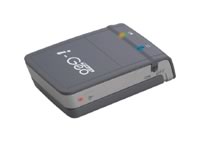Polstar igeo-plus pbt-248
1. Introduction
Polstar iGeo-Plus PBT-248 - Page 1
- Introduction
![]() Polstar Technologies is one of the few manufacturers that don't use the SiRF GPS chipsets in their devices. Instead, they incorporate Sony's 4th generation GPS chipset, the CXD2951GA-4, which promises high performance and good reception levels that match what SiRF has to offer. While doing this review, we will also be carrying out what should prove a rather interesting comparison between one of the best SiRF III enabled devices, the Globalsat BT-338, and the device under review, Polstar's i-GeoPlus PBT-248.
Polstar Technologies is one of the few manufacturers that don't use the SiRF GPS chipsets in their devices. Instead, they incorporate Sony's 4th generation GPS chipset, the CXD2951GA-4, which promises high performance and good reception levels that match what SiRF has to offer. While doing this review, we will also be carrying out what should prove a rather interesting comparison between one of the best SiRF III enabled devices, the Globalsat BT-338, and the device under review, Polstar's i-GeoPlus PBT-248.
- Polstar iGeo-Plus PBT-248
 The Polstar i-Geo PLUS is a high performance Bluetooth GPS receiver that is both compact and portable. The sleek and distinct i-Geo PLUS fits in your hand or pocket easily, allowing you to take it wherever you go. With the Polstar i-Geo PLUS, you can now add full GPS navigation capabilities to your PDA, smart phone or laptop at minimal cost while enjoying performance that rivals dedicated GPS navigators. Experienced and new users alike will be able to operate the i-Geo PLUS with minimal effort. By employing the Sony CXD2951GA-4 chipset, users will enjoy the fastest Time-To-First Fix and can begin navigation immediately.
The Polstar i-Geo PLUS is a high performance Bluetooth GPS receiver that is both compact and portable. The sleek and distinct i-Geo PLUS fits in your hand or pocket easily, allowing you to take it wherever you go. With the Polstar i-Geo PLUS, you can now add full GPS navigation capabilities to your PDA, smart phone or laptop at minimal cost while enjoying performance that rivals dedicated GPS navigators. Experienced and new users alike will be able to operate the i-Geo PLUS with minimal effort. By employing the Sony CXD2951GA-4 chipset, users will enjoy the fastest Time-To-First Fix and can begin navigation immediately.
Powered by Li-ion rechargeable batteries with an impressive battery life, the i-Geo PLUS is as easy to carry around as your mobile phone. Date transmission and connections via Bluetooth eliminate any need for wires, and the Bluetooth transmitter allows GPS data to be transmitted to your PDA, smart phone or any other Bluetooth enabled device within 10 meters. The high-sensitivity GPS receiver will pick up the weakest of signals, allowing you to place your i-Geo PLUS anywhere without compromise, and enabling you to begin navigation immediately with the very fast Time-To-First-Fix.
- Used chipset
The Sony chipset has the following specifications:
Chipset: |
Sony CXD2951GA-4 WAAS enabled |
Frequency: |
1, 1575.42 MHz |
C/A code: |
1.023 MHz chip rate |
Channels: |
12 channel all-in-view tracking |
Sensitivity |
Acquisition: -139dBm |
Position Accuracy: |
10 meters, 2D RMS |
~ 5 meters, 3D RMS WAAS |
|
Velocity: |
0.1 m/s |
Time: |
us synchronized to GPS time |
Default: |
WGS-84 Acquisition Time (Open sky, stationary) |
Reacquisition: |
0.1 sec., average |
Hot start: |
2 sec., average |
Warm start: |
35 sec., average |
Cold start: |
45 sec., average |
Altitude: |
18,000 meters (60,000 feet) max. |
Velocity: |
515 meters/second (1000 knots) max. |
Acceleration: |
Less than 4g |
Protocol messages: |
NMEA-0183 output protocol, Bluetooth |
Output format: |
GGA, GSA, GSV, RMC |
Operating temperature: |
-20° to 60° C |
Humidity: |
5% to 95% Non-condensing |
While the same in most details of the specifications, there are some minor differences between the Sony CXD2951GA-4 and the SiRF III:
- 12 satellites vs 20 satellites (SiRF III)
- Acquisition Sensitivity: -139 dBm vs -148 dBm
- Tracking Sensitivity: -152 dBm vs -159 dBm
- Hot/Warm/Cold start times of 2/35/45 vs 1/38/42 secs.
- The CXD2951GA-4 does not support the VTG output format
Something to look forward to in the results, is whether the sensitivity levels will play a major role in how good a receiver the Polestar device is compared to the Globalsat BT-338.














